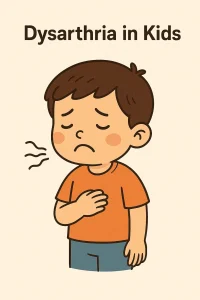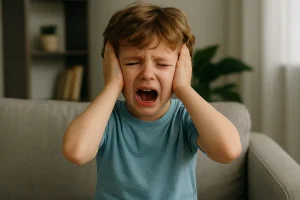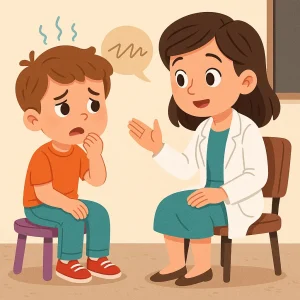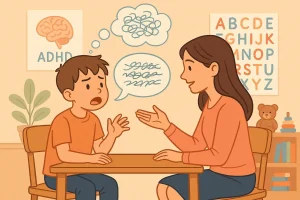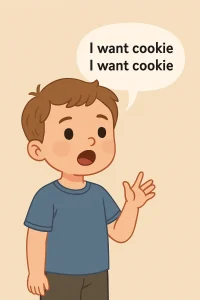Speech Sound Disorders: Causes, Treatment and Strategies
By Wellness Hub
Last Updated: October 14, 2023
Welcome to our exploration of speech sound disorders—challenges that can affect a child’s clarity of speech and their ability to communicate effectively. Speech is more than just words; it’s how we connect and share our thoughts with the world. These disorders, which may stem from various causes such as developmental speech delays or autism, can prevent children from being understood, impacting their social interactions and learning. In this article, we’ll uncover the causes, treatments, and strategies to support those affected, enhancing their ability to express themselves and engage with others around them. Join us as we delve into practical solutions to improve communication for our little ones.
Speech sound disorders can impact an individual’s intelligibility, social interactions, and communication abilities. In this article, we will explore the various aspects of speech sound disorders, including their causes, types, and potential treatments.
What are Speech Sound Disorders?
Speech sound disorders refer to issues that occur during the production of speech sounds, also known as phonemes. Speech sound disorders can affect a person’s intelligibility. Their speech makes it difficult for others to understand.
Know more about Mastering Glottal Sounds in Children: A Parent’s Guide
Types of Speech Sound Disorders
Speech sound disorders can be of two types:
- Functional speech sound disorders
- Organic speech sound disorders.
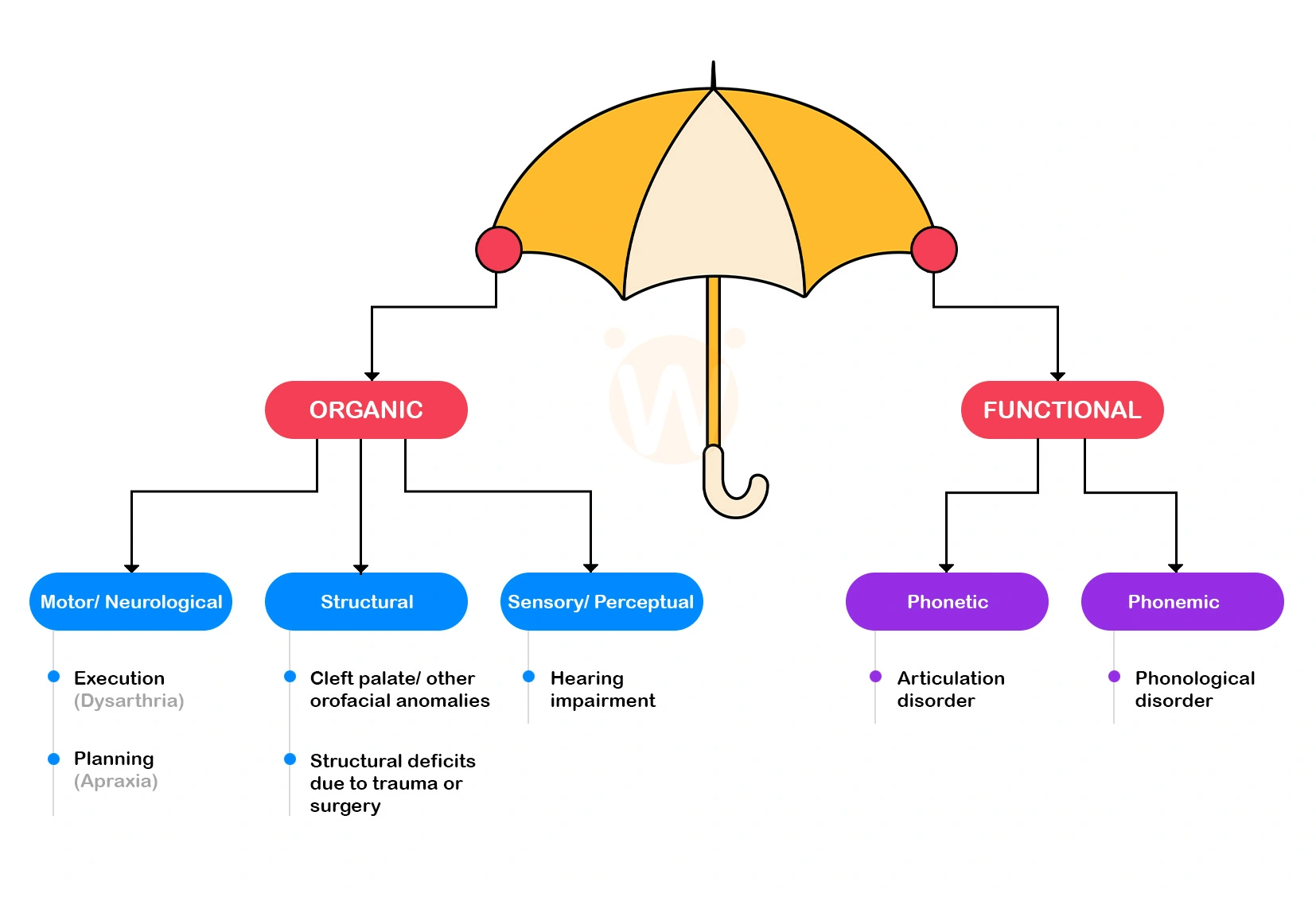
Functional speech sound disorders
Functional speech sound disorders are two types:
- Articulation disorders
- Phonological disorders
| Articulation Disorders | Phonological Disorders |
| 1. Errors at the phonetic/motoric level (difficulty producing sounds) 2. 1-2 errors that are substituted or distorted, typically in a predictable way 3. More common in older students. | 1. Errors at the phonemic/linguistic level (difficulty organizing sounds) 2. Groups of sounds or types of syllable structures are omitted, swapped, or simplified, which can be consistent or inconsistent More common in younger students. |
It is often difficult to clearly differentiate between articulation and phonological disorders; therefore, many researchers and clinicians prefer to use the broader term “speech sound disorder” when referring to speech errors of unknown cause.
Articulation disorders (Phonetic Disorders)
Articulation disorders refer to errors in the production of speech sounds. These speech sound issues can be identified in many ways, including
- Substitutions (replacing one sound with another, for example, wabbit for rabbit )
- Omissions (leaving out a sound from the word, for example, bo for boat)
- Distortions (altering the sound quality of a word, for example, shlip for sip)
- Additions (inserting extra sounds in the word, for example, “Ismayil” for “Smile”)
Any type of such issue can be identified as a problem with articulation.
Phonological disorders (Phonemic Disorders)
Phonological disorders refer to the linguistic aspects of speech. These disorders focus on predictable, rule-based errors. The issue is more about systematic patterns of errors that affect an individual’s speech intelligibility. Examples of such disorders can be
- Assimilation (Actual sound is pronounced like a neighboring sound)
- Cluster reduction (grouping neighboring consonants and reducing to one sound)
- Final consonant deletion (omitting final consonant sound in a word)
- Backing (replacing the sounds produced at the front of the mouth with the sounds produced at the back of the mouth)
- Fronting (replacing the sounds produced at the back of the mouth with the sounds produced at the front of the mouth)
- Initial consonant deletion (omitting the initial consonant sound of a word)
Understanding Organic Speech Sound Disorders
Organic speech sound disorders stem from underlying physical or neurological conditions that affect speech production. These disorders can be categorized into three main types: motor/neurological, structural, and sensory/perceptual disorders. Here’s a simple breakdown of each type:
Motor/Neurological Disorders
- Apraxia of Speech: This occurs when the brain’s signals that coordinate speech muscle movements are disrupted. Although the speech muscles are normal in strength, the brain fails to plan and execute their movements correctly, making speech difficult to articulate.
- Dysarthria: In this condition, the brain’s signals for speech muscle movement are intact, but the muscles themselves are weak. This results in slurred or slow speech that can be hard to understand.
Know more about our article on Understanding Dysarthria: Symptoms, Causes and Care
Structural Disorders
- Cleft Palate and Other Orofacial Abnormalities: Physical defects in the oral structures, such as a cleft palate or tongue-tie, can impede normal speech sound production. These issues may arise from congenital defects or injuries and often require surgical intervention to improve speech clarity.
Sensory/Perceptual Disorders
- Hearing Impairment: Hearing loss or auditory processing disorders can significantly affect how speech sounds are perceived and produced. Without accurate hearing, a child may struggle to learn how to pronounce sounds correctly, leading to speech difficulties.
| Category | Description |
|---|---|
| Motor/Neurological Condition | Childhood Apraxia of Speech (CAS): Inability to utilize motor planning to perform movements necessary for speech during a child’s language-learning process, potentially due to genetics. Similar in characteristics and treatments to AOS. |
| Dysarthria: Motor speech disorder characterized by difficulty articulating sounds due to muscle weakness in the mouth, face, and respiratory system. It can be congenital or acquired. | |
| Structural Deficits | Orofacial Anomalies: Structural anomalies like cleft lip or palate can affect speech sound articulation by impacting the movement and coordination of articulators. |
| Dental Abnormalities: Issues like malocclusions or missing teeth can affect the positioning of the tongue, lips, and teeth, impacting specific speech sounds like /s/ and /z/. | |
| Anatomical Variations: Variations in the oral cavity, palate, or pharynx can impact the resonance and articulation of speech sounds, affecting speech quality and clarity. | |
| Anatomical Abnormalities: Structures like enlarged tonsils or adenoids can obstruct airflow and lead to abnormal speech sound production. | |
| Sensory Perceptual Deficits | Hearing Loss/Auditory Processing Disorders: Can cause difficulties in perceiving and discriminating speech sounds accurately, impacting sound production. |
Causes of Speech Sound Disorders
Understanding the roots of speech sound disorders can be crucial in finding the right approach to treatment. The causes of these disorders are diverse and can range from genetic conditions to environmental influences. Here, we’ll delve into some of the common factors that may lead to speech difficulties in children.
Genetic Factors:
- Overview: Certain genetic syndromes, such as Down syndrome and fragile X syndrome, are linked to speech sound disorders. These conditions often come with a range of developmental challenges, including issues with speech.
- Impact: Genetic conditions can affect the muscle tone, cognitive development, and physical structures needed for producing clear speech.
Neurological Issues:
- Examples: Conditions like apraxia and dysarthria are neurological in origin and significantly affect speech production.
- Apraxia of Speech: This is a motor speech disorder where the brain struggles to plan and coordinate the movements necessary for speech.
- Dysarthria: This involves weaknesses or paralysis of the muscles used in speech, often making speech slurred or slow.
- Impact: These disorders require specialized interventions that may involve multiple therapies to improve muscle control and speech clarity.
Developmental Delays:
- Explanation: Some children experience delays in reaching speech and language milestones, which might indicate broader developmental delays.
- Intervention: Early detection and intervention are key in managing these delays, often involving speech therapy and parental involvement for best outcomes.
Environmental Influences:
- Factors: Exposure to multiple languages can complicate speech development, especially if there is not a consistent primary language spoken at home.
- Consideration: While bilingualism is an asset, it can temporarily appear as a speech sound disorder as children sort out the sounds from different languages.
Physical Abnormalities:
- Common Issues: Structural anomalies like cleft palate or lip, and even less visible issues such as submucous cleft palate, can interfere with the ability to produce certain speech sounds correctly.
- Treatment: Surgical interventions, along with speech therapy, are often required to address these physical challenges.
Identifying Speech Sound Disorders in Children
Recognizing the signs of speech sound disorders early in a child’s development can pave the way for effective intervention and support. Understanding the common symptoms and knowing when to seek professional advice are crucial steps for parents and caregivers.
Common Symptoms and Signs at Different Developmental Stages
Speech sound disorders manifest in various ways, depending on a child’s age and developmental stage. Here’s what to watch for:
- Toddlers (1-3 years): Difficulty with basic sound repetitions, excessive jargon with little meaningful words, and limited vocabulary compared to peers.
- Preschool (3-5 years): Challenges with sound substitutions (e.g., saying “tat” for “cat”), omissions of sounds in longer words, and difficulty being understood by family or caregivers.
- School Age (5+ years): Persistent issues with producing certain sounds correctly, such as trouble with “s,” “r,” and “l” sounds, which might still be evident in conversation.
Diagnosis by Professionals
Diagnosing speech sound disorders involves several steps and typically requires the expertise of a speech-language pathologist (SLP). Here’s how professionals typically approach the diagnosis:
- Initial Evaluation: An SLP will conduct a comprehensive speech and language evaluation, which includes observing how the child speaks in different situations, and assessing the child’s oral motor capabilities to rule out physical issues that could affect speech.
- Standardized Testing: SLPs often use a variety of standardized tests to measure aspects of speech sounds, such as articulation and phonological process, against developmental norms.
- Family and Educational Input: Gathering information from parents, teachers, and other caregivers about the child’s speech and communication abilities in different settings provides essential context for diagnosis.
- Developmental History Review: This includes reviewing the child’s developmental milestones, medical history, and any familial patterns of speech and language development.
Treatment and Therapies
Treatment for speech sound disorders typically involves a speech-language pathologist providing speech therapy. The SLP assesses the individual’s speech patterns, identifies specific sound errors or patterns, and develops a tailored treatment plan. Therapy may involve exercises to improve articulation, practice with specific speech sounds, and strategies to correct phonological patterns.
Early intervention is crucial for children with speech sound disorders, as addressing the issue during developmental years can lead to better outcomes. For adults with acquired speech sound disorders due to injury or illness, rehabilitation by an SLP can also be effective in improving speech intelligibility and communication abilities.
Treatment Strategies
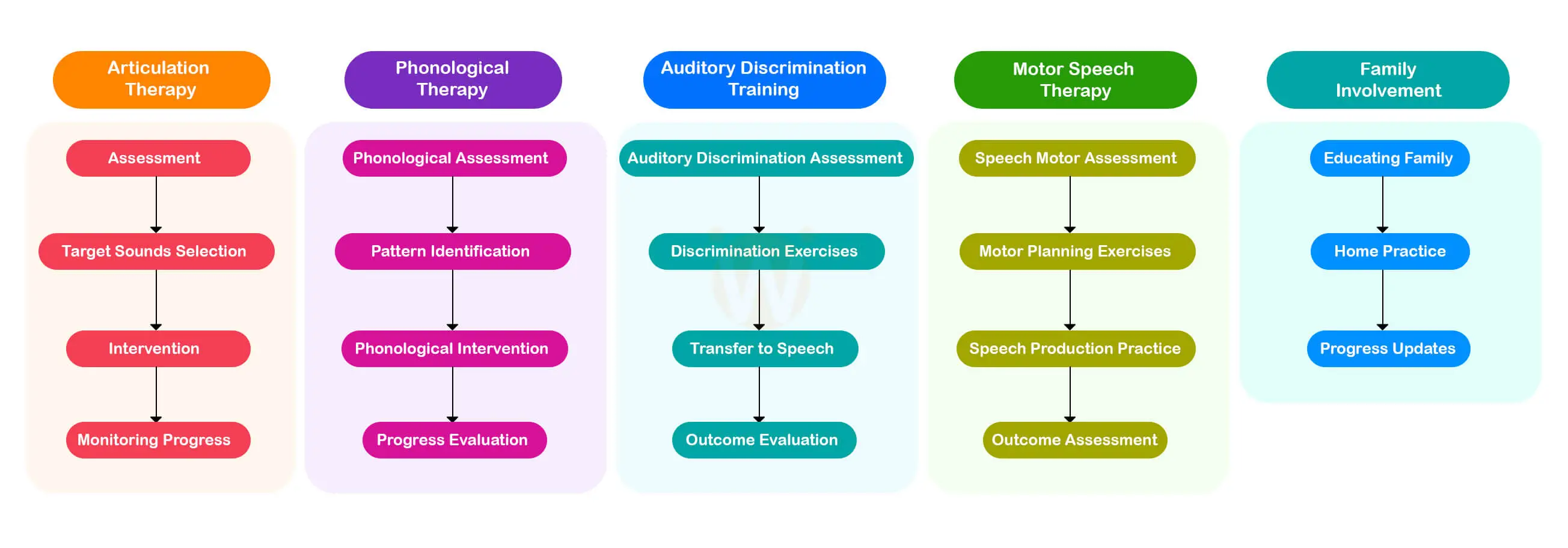
The treatment of speech sound disorders typically involves the expertise of a speech-language pathologist (SLP). The specific therapy approach depends on the individual’s age, the severity of the disorder, and the underlying causes.
The common treatment strategies include:
Articulation Therapy
During articulation therapy, a speech therapist focuses on teaching the correct placement and movement of the articulators (tongue, lips, etc.) This helps to produce specific speech sounds as accurately as possible.
Phonological Therapy
During phonological therapy, specific patterns of errors are addressed. An individual is taught the rules and patterns of their language’s sound system.
Auditory Discrimination Training
This training involves hearing and distinguishing between different speech sounds correctly. Discriminating between the actual speech sound and the pronounced sound will help an individual to learn better.
Motor Speech Therapy
During motor speech therapy, an individual is trained to gain control over motor functions of speech. The neurological conditions affecting speech are addressed during motor speech therapy.
Family Involvement
In many cases, involving the family in therapy can help reinforce progress and encourage consistent practice at home.
Though speech sound disorders impact a person’s ability to communicate effectively, early intervention strategies help significantly improve speech. Early intervention helps achieve the best outcomes, making it important to promptly address any concerns about speech sound disorders.
Conclusion
Early detection and treatment of speech sound disorders are crucial for your child’s development. At Wellness Hub, we’re dedicated to supporting every step of your child’s journey toward clearer speech. Encourage and engage with your child consistently—success comes with patience and practice. Our expert speech-language pathologists are here to offer personalized care and effective strategies tailored to your child’s needs.
Frequently Asked Question
1. What are speech sound disorders?
Speech sound disorders are conditions that impair an individual’s ability to produce speech sounds correctly, affecting their intelligibility and communication abilities. These disorders can be either functional or organic in nature.
2. What are the two main types of speech sound disorders?
The two main types of speech sound disorders are functional speech sound disorders, which include articulation disorders and phonological disorders, and organic speech sound disorders, which stem from neurological, structural, or sensory issues.
3. What is the difference between articulation disorders and phonological disorders?
Articulation disorders involve errors at the phonetic/motoric level such as difficulty producing specific sounds, while phonological disorders involve errors at the phonemic/linguistic level affecting systematic patterns of speech sounds.
4. Can speech sound disorders affect both children and adults?
Yes, speech sound disorders can affect both children and adults, although the causes and treatment approaches may differ based on the individual’s age and the underlying causes of the disorder.5.
5. What causes speech sound disorders?
Causes of speech sound disorders include developmental factors, neurological conditions, structural or physiological abnormalities, hearing impairments, and environmental influences such as exposure to non-standard dialects.
6. How are speech sound disorders diagnosed?
Speech sound disorders are typically diagnosed by a speech-language pathologist (SLP) who assesses the individual’s speech patterns, identifies specific sound errors, and determines the nature of the disorder.
7. What treatments are available for speech sound disorders?
Treatment generally involves speech therapy tailored to the individual’s needs, including articulation therapy, phonological therapy, auditory discrimination training, and motor speech therapy, depending on the type and severity of the disorder.
8. What role does early intervention play in the treatment of speech sound disorders?
Early intervention is crucial as it can significantly improve outcomes, especially in children. Addressing speech sound disorders during developmental years can lead to more effective communication skills later in life.
9. Can hearing impairment cause speech sound disorders?
Yes, hearing impairments can lead to speech sound disorders as they affect the ability to hear and thus produce speech sounds accurately. Addressing hearing issues is often a part of the treatment for speech sound disorders.
10. Why is family involvement important in treating speech sound disorders?
Involving the family in therapy can reinforce progress and encourage consistent practice at home, which is vital for the effective treatment of speech sound disorders.
About the Author:
Rajini Darugupally
M.Sc., Speech-Language Pathologist (9+ years of experience)
Rajini is a passionate and dedicated Speech-Language Pathologist with over 9+ years of experience, specializing in both developmental speech and language disorders in children and rehabilitation in adults. Driven by a desire to empower each individual to find their voice, Rajini brings a wealth of experience and a warm, genuine approach to therapy.
Currently, at Wellness Hub, she thrives in a team environment that values innovation, compassion, and achieving results for their clients.
Connect with Rajini to learn more about how she can help you or your loved one find their voice.
Book your Free Consultation Today
Parent/Caregiver Info:
Client’s Details:
* Error Message
